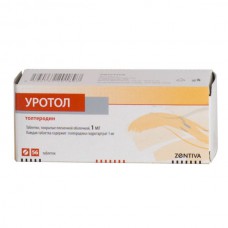Expiration date: 03/2026
Release form and composition:
Tablets, film-coated yellow color, round, lenticular.
1 tablet contains of tolterodine* tartrate 1 mg
Excipients: cellulose microcrystalline, carboximetilkrahmal sodium (type A), silica colloidal anhydrous, sodium fumarate.
The composition of the shell: hypromellose 2910/5, macrogol 6000, titanium dioxide, talc, dye iron oxide yellow.
14 PCs. - blisters (2) - packs of cardboard.
14 PCs. - blisters (4) - packs of cardboard.
Tablets, film-coated white color, round, lenticular.
1 tablet contains of tolterodine* tartrate 2 mg
Excipients: cellulose microcrystalline, carboximetilkrahmal sodium (type A), silica colloidal anhydrous, sodium fumarate.
The composition of the shell: hypromellose 2910/5, macrogol 6000, titanium dioxide, talc.
14 PCs. - blisters (2) - packs of cardboard.
14 PCs. - blisters (4) - packs of cardboard.
* international nonproprietary name, the who recommended - tolterodine.
Pharmacological action:
M-holinoblokator. As tolterodine, and its 5-hydroxymethylene derived highly specific with regard to muscarinic receptors, a competitive blocking m-cholinergic receptors, with highest selectivity to the receptors of the bladder (in comparison with receptors of the salivary glands).
The drug reduces the tone of smooth muscles of the urinary tract, contractile activity of the detrusor and reduces salivation.
In doses exceeding therapeutic, causes incomplete emptying of the bladder and increases the amount of residual urine.
The therapeutic effect of tolterodine is achieved after 4 weeks.
Tolterodine does not inhibit CYP2D6, 2C19, 3A4 or 1A2.
Pharmacokinetics:
Suction
After taking the drug inside tolterodine is rapidly absorbed from the gastrointestinal tract. Cmax in serum is reached in 1-2 hours
In the range of therapeutic doses (1-4 mg) there is a linear correlation between the value of Cmax in the serum and the dose of the drug.
The absolute bioavailability of tolterodine is 65% in individuals with CYP2D6 deficiency and 17% in most patients.
Food does not affect the bioavailability of the drug, although the concentration of tolterodine is raised when it is taken during a meal.
Distribution
Tolterodine and 5-gidroksimetil metabolite are associated primarily with orosomucoid unbound fractions are 3.7% and 36%, respectively. Vd of tolterodine is 113 L.
Due to differences in the protein binding of tolterodine and 5-gidroksimetil metabolite value of AUC of tolterodine in patients with insufficiency of CYP2D6 is close to the sum of the AUC of tolterodine and 5-gidroksimetil metabolite in the majority of patients with the same dosing regimen. Consequently, the safety, tolerability and clinical effect of the drug does not depend on the activity of CYP2D6.
Metabolism
Tolterodine is mainly metabolised in the liver via the polymorphic enzyme CYP2D6 with formation of the pharmacologically active 5-hydroxymethylene metabolite, which is then metabolized to 5-carboxylic acid and N-dezalkilirovania 5-carboxylic acid. 5-hydroxymethylene metabolite is similar to tolterodine pharmacological properties and in most patients, significantly enhances the effect of the drug.
Individuals with reduced metabolism (deficiency of CYP2D6) tolterodine is subjected to dezalkilirovania isoenzymes CYP3A4 with the formation of N-desalkilirovannogo of tolterodine, non-pharmacological activity.
Excretion
Systemic clearance of tolterodine in the serum of most patients is around 30 l/h After drug administration T1/2 tolterodine is 2-3 h, and 5-gidroksimetil metabolite - 3-4 h. in individuals with a low metabolism T1/2 is about 10 h.
Reduced clearance of the parent compound in individuals with CYP2D6 deficiency leads to increased concentrations of tolterodine (about 7 times) on the background of non-detectable concentrations of 5-hydroxymethylene metabolite.
Approximately 77% of the tolterodine is excreted in the urine and 17% in the feces. Less than 1% of the dose is excreted unchanged and about 4% - 5-hydroxymethylene metabolite. 5-carboxylic acid and N-dezalkilirovania 5-carboxylic acid are respectively about 51% and 29% of the amount that is excreted in the urine.
Pharmacokinetics in special clinical cases
The value of the AUC of tolterodine and its active 5-hydroxymethylene metabolite is increased about 2 times in patients with liver cirrhosis.
Average AUC tolterodine and 5-gidroksimetil metabolite in 2 times higher in patients with the expressed impaired kidney (speed clubockova filtering e30 ml/min). The plasma metabolites in these patients is much higher (12 times). Clinical significance of improvement in AUC of these metabolites is unknown.
Indications:
— hyperreflexia (hyperactivity, instability) of the bladder, manifested by frequent, mandatory impulses to urinate, frequent urination and/or urinary incontinence.
Dosing regimen:
The drug is administered orally 2 mg 2 times/day, regardless of meals. The total dose can be reduced to 2 mg/day based on individual tolerability Preparata.
When violations of the liver and/or kidneys, and also at simultaneous application with ketoconazole or other strong CYP3A4 inhibitors, reduce dose to 1 mg 2 times/day.
The effectiveness of therapy should be re-evaluated after 2-3 months after the start of treatment.
Side effects:
The immune system: allergic reactions, angioedema (very rare).
From the nervous system: nervousness, impaired consciousness, hallucinations, dizziness, somnolence, paresthesia, headache.
From the side of organs of vision: dry eye, disturbance of accommodation.
From the side of cardiovascular system: tachycardia, increased heart rate, arrhythmia (rare).
From the digestive system: dry mouth, dyspepsia, constipation, abdominal pain, flatulence, vomiting rare - gastroesophageal reflux.
Dermatological reactions: dry skin.
From the urinary system: urinary retention.
Other: fatigue, chest pain, peripheral edema, bronchitis, increase body weight.
Contraindications:
— urinary retention
— intractable treatment of angle-closure glaucoma
— myasthenia gravis
— severe ulcerative colitis
— megacolon
— the age 18 years
— hypersensitivity to the drug.
With caution assign product in severe obstruction of the lower urinary tract because of the risk of delay of urination, with increased risk of lower gastrointestinal peristalsis, obstructive diseases in the gastrointestinal tract (e.g. pyloric stenosis), when kidney or liver failure (daily dose should not exceed 2 mg), neuropathy, hiatal hernia of the diaphragm.
Pregnancy and lactation:
The use of Orotol when pregnancy is possible only if the expected benefit of therapy for the mother outweighs the potential risk to the fetus.
Because data on the excretion of tolterodine breast milk is not available, you should avoid using the drug during lactation.
Women of childbearing age should use reliable methods of contraception during therapy Erotola.
Special instructions:
Before treatment should rule out organic causes frequent and mandatory sneeze on urination.
Use in Pediatrics
Orotol should not be administered to children and adolescents in the return to 18 years, as at present, the safety and efficacy of the drug in this category of patients has not been studied.
Effects on ability to drive vehicles and management mechanisms
Since Orotol may cause accommodation disturbances and reduce the speed psychomotor reactions, during treatment care must be taken when driving vehicles and occupation of other potentially hazardous activities, require high concentration, psychomotor speed reactions and eyesight.
Overdose:
Symptoms: paresis of accommodation, mydriasis, painful urge to urinate, hallucinations, strong excitation, cramps, respiratory failure, tachycardia, prolonged QT interval, urinary retention.
Treatment: gastric lavage, activated charcoal. With the development of hallucinations, strong excitation - physostigmine, in convulsions or pronounced excitation - anxiolytics with benzodiazepine structure, with advanced respiratory failure - artificial lung ventilation, with tachycardia - beta-adrenoblokatora, when urinary retention - catheterization of the bladder, when mydriasis - pilocarpine eye drops and/or transfer the patient to a dark room.
Drug interactions:
Avoid the simultaneous appointment of Orotol with strong inhibitors of CYP 3A4 such as macrolide antibiotics (erythromycin and clarithromycin), antifungal agents (ketoconazole, miconazole and Itraconazole), protease inhibitors, due to the possibility of increasing the concentration of tolterodine in the blood serum, which increases the risk of drug overdose.
M-holinomimetiki reduce the effectiveness of tolterodine.
Drugs having anticholinergic properties that enhance the effect of Rotola and increase the risk of side effects.
Orotol reduces the effect of prokinetics (metoclopramide, cisapride).
Possible pharmacokinetic interaction of Orotol with drugs metabolized by cytochrome P450 isoenzymes 2D6 or 3A4 (inducers and inhibitors).
Joint application with fluoxetine (a strong inhibitor of CYP 2D6, which is metabolized to norfluoksetina, which is an inhibitor of CYP 3A4) leads only to a slight increase in the total AUC tolterodine and its active 5-hydroxymethylene metabolite that does not cause clinically significant interactions.
There is no interaction of Orotol with warfarin and combined oral contraceptives (containing ethinylestradiol/levonorgestrel).
Tolterodine is not an inhibitor of CYP2D6, 2C19, 3A4, 1A2, therefore not expected to increase levels of drugs that are metabolized by these isoenzymes in blood plasma, when co-administered with tolterodine.
Terms and conditions of storage:
List B. the Drug should be stored in a dry, inaccessible for children place. Shelf life - 3 years.



